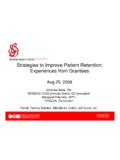Transcription of CONNECTICUT ACCESS TO RECOVERY
1 Thomas A. Kirk, Jr., , CommissionerThomas A. Kirk, Jr., , CommissionerDepartment of Mental Health and Addiction ServicesDepartment of Mental Health and Addiction ServicesA Healthcare Service AgencyA Healthcare Service AgencyJune 2006 June 2006 CONNECTICUTCONNECTICUTACCESS TO RECOVERYACCESS TO RECOVERYF ederal Substance Abuse and Mental Health Service AdministrationNational Advisory CouncilGetting StartedWe are a healthcare service healthRecover and sustain healththrough prevention and early intervention treatment and RECOVERY support services. addicts a chronic, relapsing disease severe persistent mental illness Doesn t anybody ever get better?What message are we conveying?Substance Abuse as too often viewed by Substance Abuse as too often viewed by the the funderfunderand/or service providerand/or service provider0100 SymptomsTimePerson s Entry into treatmentDischargeSevereRemissionService ResponseService Response0100 SymptomsTimeAcute symptomsDiscontinuous treatmentCrisis managementSevereRemissionRecoveryRecover y--oriented responseoriented response0100 SymptomsTimeContinuous treatment responsePromote Self Care, RehabilitationSevereRemissionMany Paths to RECOVERY Many Paths to RECOVERY DMHAS APPROACHDMHAS APPROACHS ervice System StrategiesService System StrategiesI.
2 RECOVERY Oriented Service SystemII. Value ToolsHow Does ATR Fit Into CTHow Does ATR Fit Into CT s s Larger Picture?Larger Picture? ATR is not just another program, it represents a significant investment in the promotion and enhancement of the Department s overarching goal of a RECOVERY -oriented system of care ATR builds upon a combination of previously undertaken steps and programsConnecticut s ATR Model High degree of collaboration with other targeted state agencies Five regional networks -a total of 36 clinical and 130 RECOVERY providers (including peer and faith-based) to ensure client choice One lead agency in each network assisting with implementation, certification of providers, auditing, Agencies & Programs Department of Correction Judicial Branch Department of Children and Families Department of Social Services Primary Healthcare Sites (Hospital ED & FQHC Sites) DMHAS-funded Outreach & Engagement Urban InitiativesClinical ServicesClinical Services EvaluationEvaluation Brief TreatmentBrief Treatment Ambulatory DetoxificationAmbulatory Detoxification Intensive Outpatient (IOP)Intensive Outpatient (IOP) Methadone MaintenanceMethadone Maintenance Recently implemented: an evidenced Recently implemented.
3 An evidenced based model of IOP for individuals using based model of IOP for individuals using cocaine and/or methamphetaminescocaine and/or methamphetaminesRecovery Support ServicesRecovery Support Services ShortShort--term Housingterm housing Case ManagementCase Management ChildcareChildcare TransportationTransportation Vocational/Educational ServicesVocational/Educational Services Basic Needs (food, clothing, personal care)Basic Needs (food, clothing, personal care) FaithFaith--based Servicesbased Services PeerPeer--based Servicesbased ServicesTwo thirdsTwo thirdsof CTof CT s ATR service budget is invested in s ATR service budget is invested in RECOVERY Support Services, not clinical Support Services, not clinical are RECOVERY Support Services?What are RECOVERY Support Services?Complement the focus of treatment, outreach, engagement, and other strategies and interventions to assist people in establishing an environment supportive of RECOVERY and in gaining the skills and resources needed to initiate and maintain use,Symptoms,Relapse TriggersRecovery CapitalTreatmentRecovery SupportsRecovery Capital is.
4 RECOVERY Capital is .. the quantity and quality of both internal the quantity and quality of both internal and external resources that a person can and external resources that a person can bring to bear on the initiation and bring to bear on the initiation and maintenance of recoverymaintenance of RECOVERY (W. White, 2006) (W. White, 2006) In contrast to people who achieve In contrast to people who achieve naturalnatural RECOVERY (without care), most people with RECOVERY (without care), most people with addictive disorders entering treatment have addictive disorders entering treatment have never had much RECOVERY capital or have never had much RECOVERY capital or have dramatically depleted such capital by the dramatically depleted such capital by the time they seek help. time they seek help. RECOVERY Support Services aim to: RECOVERY Support Services aim to:1)1)remove personal and environmental obstacles remove personal and environmental obstacles to RECOVERY ( , through the provision of child to RECOVERY ( , through the provision of child care or transportation)care or transportation)2)2)enhance identification of and participation in enhance identification of and participation in the RECOVERY community ( , through the RECOVERY community ( , through connecting people to treatment and to 12connecting people to treatment and to 12--step step and other mutual support/recoveryand other mutual support/ RECOVERY --oriented oriented groups) groups) 3)3)
5 Enhance the personenhance the person s s RECOVERY capitalrecovery capital ( , ( , by assisting people in addressing their basic by assisting people in addressing their basic needs, gaining employment, going back to needs, gaining employment, going back to school, forming sober social relationships, etc.)school, forming sober social relationships, etc.)Year To DateAugust 3, 2004 June 11, 2006 10,158 Unduplicated Individuals Served10,158 Unduplicated Individuals Served Year 1 Total Unduplicated Individuals: 106 Year 1 Total Unduplicated Individuals: 106 Year 2 Total Unduplicated Individuals: 10,032 Year 2 Total Unduplicated Individuals: 10,032 Received over 75,000 service level Received over 75,000 service level authorizations (clinical and/or RECOVERY authorizations (clinical and/or RECOVERY support services)support services) $10,228,529 total paid claims$10,228,529 total paid claimsDMHAS established new supportive housing units for over 550 people with psychiatric or substance use disorders.
6 Over 60% of these people are now working or in training, and their inpatient costs have decreased 70%.Based on a Corporation for supportive housing study, these supportive housing units are projected to generate over $140 million in direct and indirect economic benefits for the state. -80-60-40-200204060801% Working or in trainingInpatient costsMore people working and in housing , less inpatient costsPutting People to WorkPutting People to Work0%10%20%30%40%50%Not receiving vocational servicesReceiving vocational servicesEnhancing Employment and Self-Sufficiency through Vocational RehabilitationThe likelihood that a person served by DMHAS will become gainfully employed is more than doubled when he/she receives vocational pays!! It pays!! It pays!! Client VignettesClient Vignettes MaryMary prior to discharge from York Correctional Institute prior to discharge from York Correctional Institute for Women, met with an ATR case manager to review for Women, met with an ATR case manager to review discharge plans.
7 Discharge plans. MaryMary , through informed choice, , through informed choice, selected an intensive outpatient program from a list of selected an intensive outpatient program from a list of providers and a faithproviders and a faith--based housing provider from a list based housing provider from a list of housing providers. Additionally, the ATR case of housing providers. Additionally, the ATR case manager assisted manager assisted MaryMary with transportation from the with transportation from the correctional facility to her housing provider. Once in the correctional facility to her housing provider. Once in the community, the housing provider submitted a request on community, the housing provider submitted a request on behalf of behalf of MaryMary for food, clothing, personal care items for food, clothing, personal care items and bus passes to attend her IOP program and look for and bus passes to attend her IOP program and look for Jim was referred from the Judicial Branch-Probation Division, with a history of crack, cocaine, and alcohol abuse.
8 As an important milestone in his RECOVERY , he was returning to work as an electrical contractor. ATR paid for textbooks required for the Electrical Code Review Contractor Course and for the course itself. ATR also assisted Jim in purchasing the electrical contractor tools required for VignettesClient Vignettes Karen has been receiving substance abuse treatment funded by non-ATRsources since May 2005. She is becoming self-sufficient and is now in classes at the Stone Academy, with ATR covering textbook costs. Frank requested and is receiving ATRfinancial assistance to cover the cost of a Faith-based Men's Retreat where people support each other in their RECOVERY . Patti is attending Hairdressing school, requested and received ATRassistance in purchasing hairdressing supplies needed for her courses. Her treatment is being funded by the General Assistance VignettesClient VignettesChallengesChallenges Developing administrative infrastructure Developing administrative infrastructure A voucher program requires an agency to have A voucher program requires an agency to have infrastructure to support the necessary infrastructure to support the necessary administrative processes, including appropriate administrative processes, including appropriate documentation of delivering the servicedocumentation of delivering the service Many grassroots organizations, including faithMany grassroots organizations, including faith--based organizations, struggle with the based organizations, struggle with the paperwork that is required of a voucher (fee for paperwork that is required of a voucher (fee for service) programservice)
9 ProgramLessons LearnedLessons Learned ATR represents a major service system change ATR represents a major service system change that takes time and commitment from all entitiesthat takes time and commitment from all entities Need to support RECOVERY Support Service (RSS) Need to support RECOVERY Support Service (RSS) providers in building infrastructure to collect and providers in building infrastructure to collect and maintain client, program, and administrative maintain client, program, and administrative level data and documentationlevel data and documentation Some RSS providers overSome RSS providers over--extended themselves extended themselves on their ATR business and ignored other on their ATR business and ignored other potential revenue streamspotential revenue streamsATRATR ssImpact on the CT SystemImpact on the CT System Expands clinical continuum of care to include Expands clinical continuum of care to include Cocaine/Cocaine/MethMeth.
10 IOP and Brief Treatment Services. IOP and Brief Treatment Services Expands RECOVERY services continuum to include Expands RECOVERY services continuum to include an array of peeran array of peer--and faithand faith--based servicesbased services Adds new Adds new nonnon--traditionaltraditional provider base (peerprovider base (peer--and faithand faith--based)based) Offers extension of ATR processes and services Offers extension of ATR processes and services within CTwithin CT s General Assistance BHP ( , housing s General Assistance BHP ( , housing provider credentialing application, expansion of provider credentialing application, expansion of basic needs, etc.)basic needs, etc.) Helps to improve continuity of care and Helps to improve continuity of care and maximize existing capacity of system. maximize existing capacity of system. Helping People Move into Helping People Move into RECOVERY Zone RECOVERY Zone Improved client outcomes0100 SymptomsTimeSevereRemissionRecovery Zone RECOVERY Zone RECOVERY Zone NEXT STEPS:NEXT STEPS:SUSTAINING SUSTAINING ATRATRIN CONNECTICUTIN CONNECTICUT Enhance credentialing process for on-going monitoring of quality of care, performance, and resource efficiency; Consider formal regional networks for integrated prevention, intervention, treatment, and RECOVERY support services; Determine comparative effectiveness of RECOVERY support services, including a cost effectiveness analysis.
















